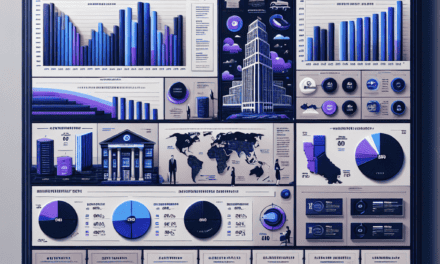“Riding the Crest: Stocks Soar as CPI Sparks Rate-Cut Hopes”
Introduction
Stocks Near New Highs as CPI Fuels Rate-Cut Expectations: Market Update
In recent market developments, stocks are approaching new highs, driven by investor optimism surrounding potential interest rate cuts. This sentiment has been fueled by the latest Consumer Price Index (CPI) data, which suggests a cooling inflationary environment. As inflation pressures appear to ease, market participants are increasingly anticipating that central banks may pivot towards a more accommodative monetary policy. This expectation of rate cuts is providing a boost to equity markets, as lower borrowing costs could stimulate economic activity and enhance corporate profitability. The current market landscape reflects a complex interplay between economic indicators and monetary policy expectations, with investors closely monitoring upcoming data releases and central bank communications for further guidance.
Impact Of CPI On Stock Market Trends
The recent surge in stock market indices has captured the attention of investors and analysts alike, as stocks approach new highs. This upward momentum is largely attributed to the latest Consumer Price Index (CPI) data, which has fueled expectations of potential rate cuts by central banks. The CPI, a critical measure of inflation, provides insights into the cost of living and purchasing power, and its recent readings have suggested a moderation in inflationary pressures. This development has significant implications for monetary policy, as central banks may consider easing interest rates to stimulate economic growth.
The relationship between CPI data and stock market trends is intricate, as inflation levels directly influence investor sentiment and market dynamics. When inflation is perceived to be under control, it alleviates concerns about the erosion of purchasing power and the potential for aggressive monetary tightening. Consequently, the prospect of stable or lower interest rates becomes more plausible, which is generally favorable for equities. Lower interest rates reduce the cost of borrowing for companies, potentially boosting corporate profits and, in turn, stock prices. Additionally, lower rates make equities more attractive compared to fixed-income investments, prompting a shift in investor preferences towards stocks.
Moreover, the anticipation of rate cuts has a psychological impact on market participants, fostering a sense of optimism and risk-taking. Investors often interpret rate cuts as a signal of central banks’ commitment to supporting economic growth, which can lead to increased market participation and higher asset valuations. This sentiment is further reinforced by the notion that lower rates can stimulate consumer spending and business investment, thereby enhancing economic activity and corporate earnings prospects.
However, it is essential to consider the broader economic context when evaluating the impact of CPI data on stock market trends. While the prospect of rate cuts can be a catalyst for market rallies, it also reflects underlying economic challenges that necessitate such measures. Persistent inflationary pressures, geopolitical uncertainties, and supply chain disruptions are among the factors that continue to pose risks to economic stability. Therefore, while the current CPI readings may suggest a favorable environment for equities, investors must remain vigilant and consider potential headwinds that could affect market performance.
Furthermore, the interplay between CPI data and stock market trends is not uniform across all sectors. Certain industries, such as technology and consumer discretionary, may benefit more from lower interest rates due to their growth-oriented nature and reliance on consumer spending. Conversely, sectors like utilities and consumer staples, which are traditionally considered defensive, may experience less pronounced gains as their appeal diminishes in a low-rate environment. This sectoral divergence underscores the importance of a nuanced approach to investment strategies, taking into account the varying sensitivities of different industries to changes in monetary policy.
In conclusion, the recent CPI data has played a pivotal role in shaping stock market trends, as it has heightened expectations of potential rate cuts by central banks. This development has contributed to the upward momentum in equities, driven by the prospect of lower borrowing costs and enhanced economic growth. However, investors must remain cognizant of the broader economic landscape and sector-specific dynamics when navigating the market. As the interplay between inflation, monetary policy, and stock market trends continues to evolve, a balanced and informed approach will be crucial in capitalizing on emerging opportunities while mitigating potential risks.
Analyzing Stocks Near New Highs Amid Rate-Cut Speculations
In recent weeks, the stock market has been abuzz with activity as several stocks approach new highs, driven by growing expectations of potential rate cuts. This optimism stems largely from the latest Consumer Price Index (CPI) data, which suggests a cooling inflationary environment. As investors digest these developments, the interplay between economic indicators and market sentiment becomes increasingly significant.
The CPI, a key measure of inflation, has shown signs of moderation, leading many to speculate that the Federal Reserve might consider easing its monetary policy. Historically, lower interest rates have been favorable for equities, as they reduce borrowing costs for companies and increase the present value of future earnings. Consequently, the prospect of rate cuts has injected a sense of optimism into the market, propelling stocks toward new highs.
Moreover, the anticipation of a more accommodative monetary stance has not only buoyed investor sentiment but also encouraged a re-evaluation of growth prospects across various sectors. Technology stocks, in particular, have been at the forefront of this rally. With their high growth potential and sensitivity to interest rate changes, tech companies stand to benefit significantly from a lower rate environment. As a result, many tech stocks have seen substantial gains, contributing to the broader market’s upward momentum.
In addition to technology, other sectors such as consumer discretionary and real estate have also experienced positive impacts. Consumer discretionary stocks, which include companies that sell non-essential goods and services, often thrive when consumers have more disposable income, a scenario likely if borrowing costs decrease. Similarly, the real estate sector, which is heavily reliant on interest rates, could see increased activity as lower rates make mortgages more affordable, potentially driving up property values and related stocks.
However, while the current market environment appears promising, it is essential to consider potential risks and uncertainties. The Federal Reserve’s decision-making process is complex and influenced by a myriad of factors beyond just inflation data. Geopolitical tensions, labor market dynamics, and global economic conditions all play a role in shaping monetary policy. Therefore, while the CPI data has fueled rate-cut expectations, it is crucial for investors to remain vigilant and consider the broader economic landscape.
Furthermore, the stock market’s recent performance has raised questions about valuations. As stocks approach new highs, concerns about overvaluation become more pronounced. Investors must weigh the potential for continued growth against the risk of a market correction. Diversification and a focus on fundamentals remain key strategies for navigating this environment.
In conclusion, the interplay between CPI data and rate-cut expectations has created a fertile ground for stocks nearing new highs. The potential for lower interest rates has invigorated various sectors, with technology, consumer discretionary, and real estate leading the charge. However, investors must remain cognizant of the broader economic context and potential risks. As the market continues to evolve, maintaining a balanced perspective and a keen eye on economic indicators will be essential for making informed investment decisions. The coming months will likely provide further clarity on the Federal Reserve’s policy direction, offering additional insights into the trajectory of the stock market.
How CPI Data Influences Investor Sentiment
The recent surge in stock market indices, reaching near all-time highs, can be largely attributed to the latest Consumer Price Index (CPI) data, which has significantly influenced investor sentiment. The CPI, a critical measure of inflation, provides insights into the cost of living and the purchasing power of consumers. When the CPI data indicates a slowdown in inflation, it often leads to increased optimism among investors, as it suggests that the central bank may consider easing monetary policy. This potential for rate cuts can stimulate economic growth by making borrowing cheaper, thereby encouraging spending and investment.
In the current economic climate, the CPI data has shown a deceleration in inflationary pressures, which has fueled expectations of a possible rate cut by the Federal Reserve. This anticipation has been a driving force behind the recent rally in stock markets. Investors are keenly aware that lower interest rates can lead to higher corporate profits, as companies benefit from reduced borrowing costs. Consequently, this can result in increased stock valuations, as the present value of future earnings becomes more attractive.
Moreover, the relationship between CPI data and investor sentiment is not merely a matter of numbers. It also reflects broader economic conditions and consumer confidence. When inflation is perceived to be under control, consumers are more likely to spend, knowing that their purchasing power is stable. This consumer confidence can translate into higher revenues for businesses, further boosting stock prices. Additionally, a stable inflation environment allows companies to plan and invest with greater certainty, fostering an environment conducive to economic growth.
However, it is essential to recognize that the influence of CPI data on investor sentiment is not always straightforward. While a lower-than-expected CPI can lead to optimism, it can also raise concerns about the underlying health of the economy. If inflation is too low, it may signal weak demand, which could be indicative of broader economic challenges. Therefore, investors must carefully analyze the context in which CPI data is released, considering other economic indicators and market conditions.
Furthermore, the global economic landscape plays a crucial role in shaping investor sentiment in response to CPI data. In an interconnected world, inflation trends in major economies can have ripple effects across global markets. For instance, if inflation in the United States is perceived to be under control, it can lead to a stronger dollar, impacting international trade and investment flows. Investors must remain vigilant, considering both domestic and international factors when interpreting CPI data and its implications for monetary policy.
In conclusion, the recent highs in stock markets underscore the significant impact of CPI data on investor sentiment. As inflationary pressures appear to ease, the prospect of rate cuts has invigorated markets, driving optimism and investment. However, investors must remain cautious, recognizing the complexities of economic indicators and the broader global context. By carefully analyzing CPI data alongside other economic factors, investors can make informed decisions, navigating the intricate landscape of financial markets with greater confidence. As the economic environment continues to evolve, the interplay between CPI data and investor sentiment will remain a critical factor in shaping market dynamics.
Rate-Cut Expectations: A Catalyst For Stock Market Growth

In recent weeks, the stock market has been buoyed by a confluence of factors, with the most significant being the growing anticipation of interest rate cuts. This optimism has been largely fueled by the latest Consumer Price Index (CPI) data, which suggests a potential easing of inflationary pressures. As a result, investors are increasingly hopeful that central banks, particularly the Federal Reserve, might pivot towards a more accommodative monetary policy. This expectation has acted as a catalyst for stock market growth, pushing indices closer to new highs.
The CPI, a key indicator of inflation, has shown signs of moderation, which is a welcome development for both policymakers and market participants. A lower-than-expected CPI reading often signals that inflation is under control, reducing the need for aggressive interest rate hikes. Consequently, the prospect of rate cuts becomes more plausible, providing a favorable environment for equities. Lower interest rates generally reduce the cost of borrowing, encouraging both consumer spending and business investment. This, in turn, can lead to higher corporate earnings, which are a primary driver of stock prices.
Moreover, the anticipation of rate cuts has led to a shift in investor sentiment, with many reallocating their portfolios towards equities. This shift is underpinned by the belief that lower rates will enhance the attractiveness of stocks relative to other asset classes, such as bonds. As bond yields decline, the relative return on equities becomes more appealing, prompting investors to seek higher returns in the stock market. This increased demand for stocks has contributed to the upward momentum in the market, pushing indices closer to record levels.
In addition to the favorable CPI data, other economic indicators have also played a role in shaping market expectations. For instance, recent employment reports have shown steady job growth, suggesting that the economy remains resilient despite global uncertainties. This resilience provides further justification for a potential rate cut, as it indicates that the economy could withstand a more accommodative monetary stance without overheating. Furthermore, corporate earnings reports have generally exceeded expectations, reinforcing the positive outlook for stocks.
However, it is important to note that while the prospect of rate cuts is a significant driver of market optimism, it is not the sole factor at play. Geopolitical developments, trade negotiations, and fiscal policies also continue to influence market dynamics. Investors remain vigilant, aware that any adverse developments in these areas could temper the current bullish sentiment. Nonetheless, the prevailing narrative is one of cautious optimism, with many market participants betting on a favorable outcome.
In conclusion, the anticipation of interest rate cuts, spurred by encouraging CPI data, has emerged as a key catalyst for stock market growth. This expectation has not only bolstered investor confidence but also led to a reallocation of assets towards equities, driving indices closer to new highs. While other factors continue to play a role in shaping market dynamics, the potential for a more accommodative monetary policy remains a central theme. As investors navigate this complex landscape, the interplay between economic indicators and central bank actions will likely continue to be a focal point in the weeks and months ahead.
Strategies For Investing In Stocks At New Highs
As stocks approach new highs, driven by recent Consumer Price Index (CPI) data that has fueled expectations of potential rate cuts, investors are faced with the challenge of navigating an increasingly dynamic market environment. The anticipation of rate cuts often leads to a surge in stock prices, as lower interest rates typically reduce borrowing costs for companies and increase consumer spending, thereby boosting corporate earnings. However, investing in stocks at new highs requires a strategic approach to mitigate risks and capitalize on potential opportunities.
One effective strategy is to focus on diversification. By spreading investments across various sectors and asset classes, investors can reduce the impact of volatility in any single area. This approach not only helps in managing risk but also allows investors to capture gains from different segments of the market that may perform well under varying economic conditions. For instance, while technology stocks might surge due to increased consumer spending, defensive sectors like utilities and healthcare can provide stability during market fluctuations.
Moreover, it is crucial to conduct thorough research and analysis before making investment decisions. Understanding the fundamentals of companies, such as their earnings growth, debt levels, and competitive positioning, can provide valuable insights into their potential for long-term success. Additionally, keeping an eye on macroeconomic indicators, including inflation rates and employment figures, can help investors anticipate market trends and adjust their strategies accordingly.
Another important consideration is the valuation of stocks. When stocks are near new highs, they may be trading at elevated price-to-earnings (P/E) ratios, which could indicate that they are overvalued. Investors should be cautious and consider whether the current stock prices are justified by the companies’ earnings prospects. Employing valuation metrics such as the P/E ratio, price-to-book ratio, and dividend yield can aid in assessing whether a stock is fairly priced or if it might be due for a correction.
Furthermore, maintaining a long-term perspective is essential when investing in stocks at new highs. While short-term market movements can be unpredictable, focusing on the long-term growth potential of investments can help investors stay committed to their strategies. This approach involves setting clear investment goals, such as retirement savings or wealth accumulation, and aligning investment choices with these objectives. By doing so, investors can avoid making impulsive decisions based on short-term market fluctuations.
In addition to these strategies, it is beneficial to stay informed about monetary policy developments. The expectation of rate cuts, as suggested by the recent CPI data, can significantly influence market sentiment and stock prices. Investors should monitor announcements from central banks and be prepared to adjust their portfolios in response to changes in interest rates. For example, if rate cuts are implemented, growth stocks may benefit more than value stocks, as lower rates can enhance their future earnings potential.
In conclusion, investing in stocks at new highs requires a well-thought-out strategy that balances risk and reward. By diversifying portfolios, conducting thorough research, evaluating stock valuations, maintaining a long-term perspective, and staying informed about monetary policy, investors can navigate the complexities of the market and position themselves for success. As the market continues to evolve, these strategies can serve as a foundation for making informed investment decisions in an environment characterized by both opportunities and uncertainties.
The Role Of Economic Indicators In Stock Market Performance
Economic indicators play a crucial role in shaping stock market performance, serving as vital tools for investors and policymakers alike. Among these indicators, the Consumer Price Index (CPI) holds particular significance, as it provides insights into inflationary trends that can influence monetary policy decisions. Recently, the stock market has been approaching new highs, driven in part by expectations of potential rate cuts fueled by the latest CPI data. Understanding the interplay between economic indicators like the CPI and stock market dynamics is essential for comprehending the broader financial landscape.
The CPI measures the average change over time in the prices paid by urban consumers for a market basket of consumer goods and services. As a key indicator of inflation, it helps gauge the purchasing power of consumers and the cost of living. When the CPI indicates rising inflation, it often prompts central banks to consider tightening monetary policy by raising interest rates to curb inflationary pressures. Conversely, a lower-than-expected CPI can lead to expectations of rate cuts, as central banks may seek to stimulate economic activity by making borrowing cheaper.
In the current market environment, the latest CPI figures have shown a moderation in inflation, which has sparked optimism among investors. This optimism is rooted in the belief that central banks, such as the Federal Reserve, might be more inclined to lower interest rates in response to subdued inflationary pressures. Lower interest rates can reduce the cost of borrowing for businesses and consumers, potentially boosting economic growth and corporate profits. Consequently, the prospect of rate cuts has contributed to the stock market’s upward momentum, as investors anticipate a more favorable economic environment.
Moreover, the relationship between economic indicators and stock market performance is not always straightforward. While a lower CPI can lead to expectations of rate cuts, it is essential to consider other factors that may influence market sentiment. For instance, geopolitical developments, corporate earnings reports, and changes in consumer confidence can all impact investor behavior. Therefore, while the CPI is a critical piece of the puzzle, it is not the sole determinant of stock market trends.
In addition to the CPI, other economic indicators such as employment data, gross domestic product (GDP) growth, and consumer spending also play significant roles in shaping market expectations. Employment data, for example, provides insights into the health of the labor market and consumer spending power. Strong employment figures can signal robust economic growth, potentially leading to higher corporate earnings and stock prices. Conversely, weak employment data may raise concerns about economic slowdown, influencing market sentiment negatively.
As investors navigate the complexities of the stock market, understanding the interplay between economic indicators and market performance becomes increasingly important. By analyzing these indicators, investors can make more informed decisions and better anticipate potential market movements. However, it is crucial to approach these analyses with a comprehensive perspective, considering the broader economic context and other influencing factors.
In conclusion, economic indicators such as the CPI play a pivotal role in shaping stock market performance by influencing expectations around monetary policy. The recent moderation in CPI has fueled hopes of rate cuts, contributing to the stock market’s approach to new highs. Nevertheless, investors must remain vigilant, considering a range of economic indicators and external factors to gain a holistic understanding of market dynamics. By doing so, they can better navigate the complexities of the financial landscape and make informed investment decisions.
Navigating Market Volatility With Rate-Cut Anticipations
In recent weeks, the stock market has been navigating a landscape marked by volatility, yet optimism has emerged as stocks approach new highs. This buoyancy in the market is largely driven by the latest Consumer Price Index (CPI) data, which has fueled expectations of potential rate cuts by the Federal Reserve. Investors are closely monitoring these developments, as the interplay between inflation metrics and monetary policy decisions continues to shape market dynamics.
The CPI, a key indicator of inflation, has shown signs of moderation, suggesting that the aggressive interest rate hikes implemented over the past year may be yielding the desired effect of cooling inflationary pressures. As a result, market participants are increasingly hopeful that the Federal Reserve might pivot towards a more accommodative monetary stance. This anticipation of rate cuts is providing a tailwind for equities, as lower interest rates generally reduce borrowing costs for companies and can lead to higher valuations.
Moreover, the prospect of rate cuts is particularly appealing to growth-oriented sectors, such as technology and consumer discretionary, which are sensitive to changes in interest rates. These sectors have been among the primary beneficiaries of the recent market rally, as investors seek opportunities in areas that stand to gain the most from a potential easing of monetary policy. Consequently, the anticipation of rate cuts is not only influencing stock prices but also shaping sectoral performance within the broader market.
However, it is important to recognize that the path to potential rate cuts is not without its challenges. The Federal Reserve remains vigilant in its commitment to achieving its dual mandate of maximum employment and price stability. While the recent CPI data provides some reassurance, policymakers are likely to weigh a multitude of economic indicators before making any definitive moves. This cautious approach underscores the complexity of the current economic environment, where the balance between fostering growth and curbing inflation remains delicate.
In addition to domestic factors, global economic conditions also play a crucial role in shaping market sentiment. Geopolitical tensions, supply chain disruptions, and varying recovery trajectories across different regions add layers of uncertainty to the economic outlook. These factors can influence the Federal Reserve’s decision-making process, as external shocks have the potential to impact inflation and growth prospects.
As investors navigate this period of market volatility, diversification remains a key strategy. By spreading investments across different asset classes and sectors, investors can mitigate risks associated with potential market fluctuations. Furthermore, maintaining a long-term perspective can help investors weather short-term volatility and capitalize on opportunities that may arise from shifts in monetary policy.
In conclusion, the anticipation of rate cuts, fueled by recent CPI data, has injected a sense of optimism into the stock market, propelling stocks towards new highs. While this development is encouraging, it is essential for investors to remain vigilant and consider the broader economic landscape. The Federal Reserve’s cautious approach, coupled with global uncertainties, suggests that the path forward may be complex. By staying informed and adopting prudent investment strategies, investors can effectively navigate the current market environment and position themselves for potential opportunities that may arise from future monetary policy shifts.
Q&A
1. **What is the significance of stocks nearing new highs?**
– Stocks nearing new highs often indicate strong market momentum and investor confidence, suggesting potential continued upward movement.
2. **How does the Consumer Price Index (CPI) influence rate-cut expectations?**
– A lower-than-expected CPI can signal reduced inflationary pressures, leading investors to anticipate potential interest rate cuts by central banks to stimulate economic growth.
3. **Which sectors are most likely to benefit from rate-cut expectations?**
– Sectors such as technology, real estate, and consumer discretionary often benefit from rate-cut expectations due to lower borrowing costs and increased consumer spending.
4. **What are the potential risks of investing in stocks near new highs?**
– Risks include overvaluation, potential market corrections, and external economic factors that could reverse the upward trend.
5. **How do rate-cut expectations impact bond markets?**
– Rate-cut expectations typically lead to lower bond yields as investors anticipate lower future interest rates, increasing the attractiveness of existing bonds with higher yields.
6. **What role do central banks play in shaping market expectations?**
– Central banks influence market expectations through monetary policy decisions, guidance on future rate changes, and their assessments of economic conditions.
7. **How can investors capitalize on stocks near new highs amid rate-cut expectations?**
– Investors can capitalize by identifying strong-performing sectors, diversifying portfolios, and staying informed about economic indicators and central bank policies.
Conclusion
Stocks nearing new highs amid expectations of rate cuts driven by CPI data suggest a positive market sentiment. Investors anticipate that lower interest rates could stimulate economic growth, benefiting equities. However, this optimism must be balanced with caution, as external factors and potential inflationary pressures could impact future market dynamics. Overall, the current environment reflects a hopeful outlook for stocks, contingent on favorable economic conditions and monetary policy decisions.





